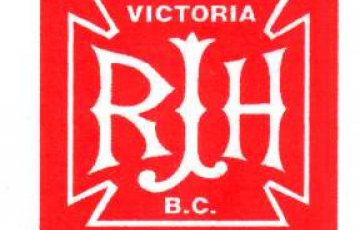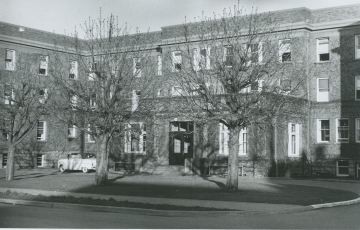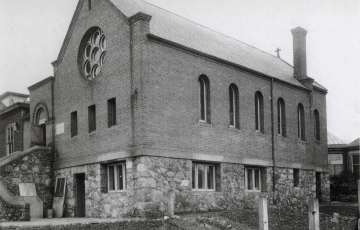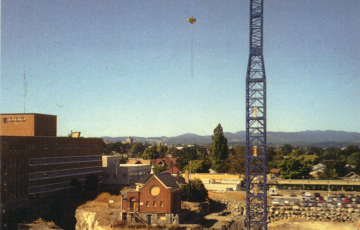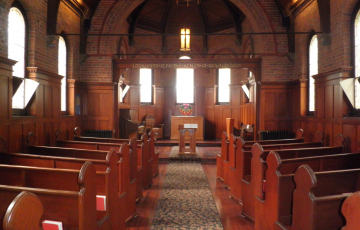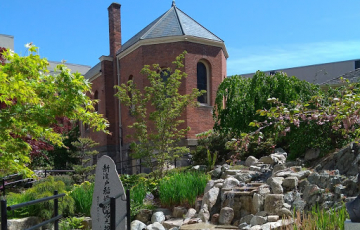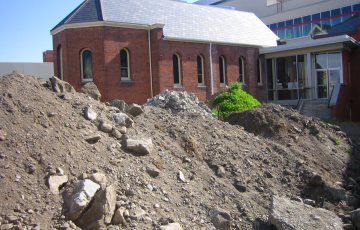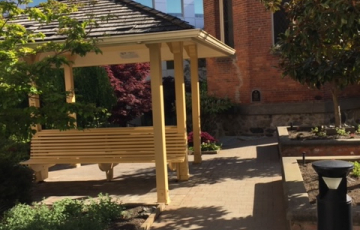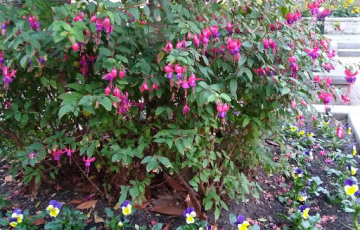Alumnae Association of the Royal Jubilee Hospital School of Nursing
"Non sibi, sed toti (Not for ourselves, but others)"
Overview
In 1920, the Alumnae Association of the Royal Jubilee Hospital School of Nursing was formed by graduates. The association was very active until the end of 2019.
While the alumnae had a social function and a means to keep in contact with the graduates, the association completed valuable projects.
Read more on this page to learn about their achievements.
The alumnae thanks the staff and administration of the Royal Jubilee Hospital and Island Health for many years of collaboration and support.
History of the Association through the years
- 1890s
-
Exterior of nurses' residence in Begbie Hall. Photo courtesy BC Archives
The Provincial Royal Jubilee Hospital opened its doors on May 21,1890 and in July only had three nurses to care for 120 patients. By August the Board of Directors had decided to establish a training school for nurses as a solution to its financial problems of non-paying patients and lack of government funding. Bright, dedicated, single women were willing to provide service (manual labour) for free room and board and a stipend of $5 a month. The two-year program began with two students in August 1890 and was not officially opened until December 1891 when it became the first nursing school West of Winnipeg and North of San Francisco.
Early training involved only hands on instruction in basic cleanliness, neatness, and patient comfort, including tending fireplaces, coal lamps and preparing meals. By 1893 the medical staff at RJH began to give lectures. Clinical experience consisted mostly of medical patients with skin ulcers, pneumonia and infectious diseases. The number of pediatric and surgical patients was limited and there were no maternity or psychiatric patients. Student nurses were in the hospital on nights managing a ward alone and often sharing care with a graduate nurse for forty patients during the day shift. Sterilization and septic procedures were just beginning to be used and student nurses spent a full day boiling and drying bandages.
The training school grew slowly over this decade as students were only admitted when nursing staff levels in the hospital fell. Physicians were in control of everything even accepting and screening nursing student applicants. By 1899 there were only 31 graduates, 17 enrolled students, and more applicants than could be accepted.
Selfless devotion and military-style discipline were firmly rooted in the nursing profession as the 19th century came to an end.
- 1900-1920
-
Over this period rapid improvements to the Royal Jubilee Hospital (RJH) meant expanded clinical experiences for the student nurses. For example, a TB isolation unit, a pediatric ward, and by 1916 a maternity ward. Also, the operating rooms became busier and delirium treatment became available. In 1917 the program length was increased from 2.5 years to 3 years.
Since the opening of the school, student nurses were required to live in residence and were first housed in the RJH administration building and a rental house a few blocks away. In 1909 a new two-storey brown- shingled nurses’ residence located on hospital property was opened and ten years later an addition for class space and bedrooms doubled the capacity to sixty-one student nurses. There were many rules that the students had to obey in the residence. Rulebooks issued to new students addressed everything from curfews, visitors, hours of sleep, bathtub use, and bed making to the proper storage of clothing.
RJH and its training school felt the impact of World War I (1914-1918). In total, 46 RJH graduates served overseas during the war and three of those graduates lost their lives. Until 1919, there was a constant appeal for more nursing students due to a lack of RJH graduates continuing at the hospital and many injured soldiers returning and requiring hospital care. To improve enrollment the student nurses’ education and conditions were improved. They now had, free of charge, medical care, textbooks, a library, dedicated classrooms, nursing supervision during clinical experience, nursing instructors and a curriculum with more focus on nursing care. In addition, small hospitals on Vancouver Island were sending their students to complete their final two years of “training” at RJH. By 1919 the recruitment was successful as student enrollment had increased from 28 to 61.
Culturally, women in Canada were beginning to speak up about having voting rights and establishing independent lives away from home. By 1905 the RJH graduates had organized the first nurses’ group in B.C., who with other graduates, worked over this decade to form the BC Graduates Association (later the Registered Nurses Association of BC). This association pressured the BC government to pass the first Graduate Nurses Act in April 1918 which provided the legal framework to set and enforce standards for training schools including reduced working hours for student nurses and a nursing registration (RN) exam.
- 1920-1950
-
Post war and the ‘roaring twenties’ saw more independence for women and freedom from Victorian morals. Short hair, Christmas parties, dances and chaperoned visits to opera and symphony events became common place. Student nurses were still in demand to staff RJH because of a new wing and an increase of 207 beds plus operating rooms. After 1926, instruction for students started to include psychiatric, pediatric and operating room nursing.
With the continuing increase in student nurse enrollment it became obvious that a new, bigger nurses’ residence was needed. In 1930 the current three storey brick building on Richmond Road was opened as “The Nurses Residence”. A total of 209 student nurses were housed in either single or double rooms. The residence was the students’ home in which lifelong friendships were fostered. It served as an informal environment in which personal issues and problems arising from ward experiences were solved and ever-present high jinks abounded as a way to let off steam. House mothers were introduced to ensure safety in the residence, manage house rules, and often provided comfort for students pining for home and family.
The economic depression of the thirties was cause for widespread unemployment in Canada and RJH nursing graduates were no exception. This situation gave rise to a report on nursing education in Canada (Weir, 1931) that recommended student nurses be trained in an educational institution rather than being an economic asset to the hospital. Despite the recommendations and logic of the Weir report, it took another fifty years and more national reports before the RJH was forced to close their training school. Although most nursing schools reduced enrollment in the 30s, in BC 12 out of 19 nursing schools closed.
During World War II (1939-45) the RJH suffered again with a shortage of nurses due to graduates serving overseas and the reduced school enrollment during the depression. This meant extra duties required of student nurses, and retired RJH graduates were coaxed back into service. By the end of the war, 72 RJH graduates had served with the Canadian armed forces and all returned. Several commemorative plaques in the RJH Pemberton Memorial Chapel, honor their service.
After the war students’ clinical experience became more varied with the introduction of time spent in the community, and on cancer, isolation, and veterans’ units. Clinical shifts became 8 hours with 1 day off per week and the curriculum was formalized using a “block” system. This increased the number of classroom hours and slightly reduced the clinical hours, ensuring the student nurses were less fatigued and had more time for study. By 1949 the RJH nursing students joined others in North America in writing the National League of Nursing exam for RN registration.
- 1950-1983
-
In 1950 the nursing program title changed from a “Training School” to “School of Nursing”. The school became affiliated with the Provincial Mental Hospital at Essondale (Coquitlam BC) and students could opt to take an 8 -week course of lectures and practical experience in psychiatric nursing. By the mid-1950s the school’s enrollment dropped as young women had more career opportunities. To improve enrollment the hospital board agreed to increase the monthly stiped for student nurses to $9, $12 and $15 depending on the year they were in and reduced their work week to 5.5 days. This strategy was so successful that by 1959 the faculty needed to be more selective when choosing from the large applicant pool.
There were 74 RJH student nurses graduating in 1961, the largest number since the school opened in 1890. Development of plans for a bigger residence began in 1965 but halted in 1967 as the hospital board learned that nursing education in Canada was moving out of hospitals. This was supported by the RJH School’s Director and faculty who suggested that the current program was educationally unsound and a danger to safe nursing care. They proposed a nursing degree program at UVIC which collapsed in 1968 and their plan for an enriched two-year nursing diploma program at RJH was halted by late 1969. In the meantime, student nurses were allotted a 4-week annual vacation and in 1969 allowed to live out of residence and to be married.
Even though nursing students were becoming more emancipated, they were still required to open doors for students more senior to them, graduates, supervisory staff and doctors. This and other doctor nurse rituals were the norm until the mid 1970s. Around this time the nurses’ residence became less and less a hub of social activity as monetary incentives for living out and not using the hospital cafeteria when off duty meant fewer students in residence. By 1980 less than fifty percent of the nursing students lived full time in the nurses’ residence. (NOTE: after the school closed, the Canadian government in 1989 designated the nurses’ residence (called Begbie Hall) as a national heritage site.
By 1971 two-year diploma programs had begun in four BC community colleges causing two hospital-based nursing programs to close (St. Paul’s and Royal Inland). At RJH the delay in planning a two-year diploma program was due to hospital finances, students providing service, and reduced funding from the BC Ministry of Health. In 1974 the RJH board made the decision to phase out the nursing school but with no fixed date. Finally, in 1975 the students service commitment to the hospital ended. At that time their course work was increased to 23 months, including a course at UVIC and 10 months of practicums.
Support for a nursing degree program at UVIC was unanimous by hospital and education officials in early 1977. Late in 1978 the BC government announced that the RJH nursing school would be phased out and replaced with a two-year nursing diploma program to begin at Camosun College in Fall 1980. This overlapped with the 224 nursing students still in the RJH program in 1980 and required cooperative planning with Camosun and the hospital administration to ensure adequate practicum placements.
A severe economic recession hit in 1981 to 1983 which meant there were few if any jobs for the nursing graduates in both the college and hospital programs. The final 28 students of the RJH School of Nursing class of January 1983 graduated in a ceremony on December 5, 1982. In over ninety-three years of operation from 1890 to 1983, this hospital-based diploma nursing program graduated 3,247 nurses.
- Uniforms
-
From the opening of the school, nursing students had to wear a uniform of a blue and white pin striped cotton dress covering the ankles and with long sleeves. Over this came a starched white bib and apron of the same length with added collars and cuffs. Puffed caps with frilly brims sat forward on the pompadour hair style until the turn of the century when the frilly brim was replaced with a starched wide brim. High black laced boots and black stockings were worn up until 1928. In 1897, at graduation, gold pins in the shape of a Maltese cross were introduced which became smaller in size over the decades.
Changes to the uniforms in the first half of the 20th century were made to reflect advancements in sepsis, surgical procedures and nursing care. Long sleeves were unclean, long skirts inhibited the kind of movements required to safely provide patient care. By the 1950-1960s short sleeves, knee length skirts, white nylon stockings and shoes were the norm. Over the 20th century other changes included: a gold bar pin worn at the neck was awarded to students entering second year and a dark blue velvet band worn along the top of the cap was awarded to students entering third year. Even though society changed radically for women over this century, the strict rules regarding a nurse’s appearance in uniform were slow to reform. Student nurses were only allowed to wear their complete uniform while on duty or during classroom lectures. They were also warned against using too much make-up, nail polish, perfume and jewelry as not being in good taste or becoming of a professional nurse.
With the wave of feminism in the early 1970s and as laundry practices altered, the student uniform changed from a heavy starched bib, apron, and collar over the pin striped basic dress to a one-piece white polyester/cotton uniform. The class of September 1974 was disappointed to be the first class to wear this slim line uniform and a cap with red bands.
- Learn More
-
George Weir, Survey of Nursing Education in Canada (Toronto: University of Toronto Press, 1932)
Anne Pearson, The Royal Jubilee Hospital School of Nursing 1891-1982 (Victoria: The Alumnae Association of the Royal Jubilee School of Nursing, 1985; Victoria: Morriss Printing Company Ltd, 1985)
On closure of the Alumnae Association of the RJH School of Nursing (December 2019) a major collection of uniforms, artifacts, and memorabilia of the nursing school and student nurses’ life were sent to the Royal BC Museum. For research or further information please contact their Human History department of the Royal BC Museum and for photographs and records the BC Archives.
Read more about the the national historical designation of the RJH nurses residence “Begbie Hall”.
Scholarships, Pemberton Chapel, Jubilee Heritage Gardens, Museum and Archives
-
Nursing Education Scholarships and Bursaries
-
The Alumnae Association of the Royal Jubilee Hospital School of Nursing supports nursing education through several scholarships and bursaries.
- The RJH School of Nursing Alumnae Bursary is available through the Registered Nurses Foundation of British Columbia.
- The RJH School of Nursing Alumnae Association Student Award is an entrance scholarship and available through the University of Victoria.
- The RJH School of Nursing Robins/Irving/Rossiter Nursing Scholarship is open to current Island Health employees who also meet the eligibility criteria below. More information about this scholarship is available on the Island Health intranet (accessible only to those with a current user ID and log-in permissions) in the Scholarships section.
Who is eligible to apply for these scholarships and bursaries?
All RJH School of Nursing graduates, their immediate family, or descendants (e.g. spouse, child, sibling, grandchild, and anyone else related by birth or adoption in perpetuity) can apply for any one of the scholarships or bursaries listed above.
What information does an applicant need to apply for these scholarships and bursaries?
Applicants need to provide the following information:
- their relationship to the RJH School of Nursing graduate (e.g. child, grandchild)
- the name (and maiden name, if applicable) of the RJH School of Nursing graduate
- the year of graduation of the RJH School of Nursing graduate
How do I request a transcript for an RJH School of Nursing graduate?
For RJH School of Nursing Transcripts, contact EmployeeRecords@islandhealth.ca.
-
Pemberton Memorial Chapel
-
Photo courtesy BC Archives
In 1909, Mrs. Teresa Pemberton donated funds for the construction of the RJH Pemberton Memorial Chapel in memory of her late husband, Joseph D. Pemberton, “for the benefit of patients and their families of all denominations.” The Chapel exterior was designed by J.C.M. Keith, who designed Christ Church Cathedral in Victoria. The interior was designed by Sophie Drummond, the Pembertons’ daughter, who was an artist and contemporary of Emily Carr.
An elaborate three-hour service was conducted to dedicate the Chapel on December 29, 1909, by Bishop Perrin (Anglican Diocese of British Columbia), assisted by the Reverend Joseph McCoy (Knox Presbyterian Church), the Reverend T.W. Gladstone (Reformed Episcopal), and the Reverend Carson from the Baptist Church.
Between 1904 and 1924, the Chapel was used as a maternity ward and later became a male convalescent ward for soldiers returning from war.
The multi-faith sanctuary was restored and returned to its original use in 1925. At that time, weekly services at 6 am were compulsory for all nursing students. A nursing diary described how student attendance suddenly improved in 1943 when the “handsome” Bishop Coleman arrived to conduct Chapel services.
In 1979 the Chapel was dedicated as a Heritage Building by the City of Victoria. Sadly, a year later the chapel was deemed unsafe and boarded up when extensive renovations physically isolated and disconnected the Chapel from the hospital.
Photo courtesy BC Archives
Twenty years later, the President of the Alumnae Association of the RJH School of Nursing was appalled to learn about, then see, the state of the Chapel. Soon after, she approached Greater Victoria Hospital Society (GVHS) with a $500 donation to be used as seed money for a restoration project.
By 1997, a Chapel redesign proposal by Paul Merrick Architects was agreed to by the GVHS Board of Directors. Farmer Construction Company in Victoria was awarded the contract, and in 1998 the RJH Heritage Building Restoration Committee was formed.
To begin the project, the rock face under the Chapel was dynamited and cleared to provide a useable space. Complicated seismic upgrading of the heritage building continued as Farmer Construction Company proceeded on the project. Company workers were so intensely involved that they often worked after hours on their own time.
Over the next five years, Alumnae members dedicated themselves to fundraising assisted by RJH Spiritual Health leaders, provincial grants, community donations and services in kind. The Alumnae Association alone raised and donated $800,000.Several historic additions enhanced the beauty and story of the Chapel.
• The WW 1 Nursing Sisters stained-glass window designed by Maurice Hartle, an Orderly at the Veterans Hospital, was relocated from the RJH Memorial Pavilion to the Pemberton Chapel’s vestibule in 2002.
• Two framed scrolls honouring Nursing Sisters in WW1 and WW2 hang on the walls in the Chapel sanctuary.
• A bronze statue of a graduate in uniform was commissioned by the Alumnae to recognize all graduates from the RJH School of Nursing. Measuring 57 cm, it was sculpted by Nathan Scott.
• A Casavant Pipe Organ, handcrafted in Quebec, was installed in the organ loft. This unique organ was donated by a Royal Jubilee Hospital graduate in 2002.
• Colourful oil paintings of angels were created on the side of the cross beams inside the Chapel by a student nurse in the 1950’s.
• New antique ceiling lights were found to replace the existing lights.
• The pump organ in the chancel, of the same age as the Chapel, was the gift of a private donor in 2019.
Pemberton Chapel Reopens June 20, 2003
The special event was attended by twenty members of the Pemberton family whose strong connection to the hospital dates back to 1858, when A. F. Pemberton, Magistrate and Director of the Bishop Cridge Hospital, raised funds for the new Provincial Royal Jubilee Hospital.
In 2004, The Pemberton Memorial Chapel was the proud recipient of the Heritage Building Restoration Award given by the Victoria Real Estate Board.
For the following 15 years, the Alumnae Volunteers of the Chapel welcomed patients, their families, staff and visitors into this sacred space.
In June 2005, the RJH School of Nursing Archives/Museum opened to the public for research and general viewing. This Museum became known for the depth of its nursing history. Graduates provided their oral histories that were then transcribed to become part of the permanent collection. Antiquities from the nurse’s residence, teaching labs and the Jubilee hospital also added unique dimensions to those stories.
Through the ensuing years, members of the Royal Canadian College of Organists assisted the Alumnae with weddings, memorials, fundraising concerts and annual Christmas sing-alongs in the Chapel for the enjoyment of patients, their families and visitors.
With the dissolution of the RJH School of Nursing Alumnae Association, the stewardship of the Pemberton Memorial Chapel was officially transferred to the Royal Jubilee Hospital on March 20, 2019.
The RJH School of Nursing graduates have had a long and memorable association with the Pemberton Memorial Chapel and are proud to consider the Chapel our permanent legacy.
Photo courtesy BC Archives
-
Jubilee Heritage Gardens
-
The Alumnae Association of the Royal Jubilee School of Nursing is proud to have played an integral part in uniting the three Royal Jubilee Hospital Memorial Gardens. They are the Pemberton Chapel Garden, the Pemberton Operating Room Garden, and the Dr. Inazo Nitobe Memorial Garden, located on the lower level courtyard. Each garden was funded and created independently of one another.
Dr. Inazo Nitobe Memorial Japanese Garden
In the spring of 2003, following the opening of the chapel, the alumnae of the RJH School of Nursing completed fundraising for an elaborate landscaping plan.
Landscaping preparations outside the chapel
The three gardens were coordinated under the direction of volunteer horticulturist, Brian Stretch. Brian's dedication and invaluable expertise assisted the alumnae and the hospital departments to complete the overall project.
Nurseries, local businesses, and alumnae members made generous contributions to enhance the beauty and function of the gardens. Memorial benches, a semi-circular arbor, ornamental trees, shrubs, amd perennial plants were donated. Water features, irrigation equipment, and pathways were also installed.
After four years of development, the Pemberton Chapel Garden was officially opened on July 24, 2007. For the following 12 years, a small group of alumnae dedicated themselves to planting, pruning, mulching, and genereal seasonal garden maintenance under Brian's leadership.
In 2010, a unique streetcar shelter was lifted by crane from its previous site on Richmond Road and placed in the Pemberton Chapel Garden courtyard. This historic shelter that previously serviced the #10 route from 1890 to 1947, is on the City of Victoria heritage registry.
Heritage streetcar shelter in the chapel garden courtyard
The stewardship of the Jubilee Heritage Gardens was officially transferred in June 2019 to the Royal Jubilee Hospital Facilities Maintenance Department.
Dissolution of the Royal Jubilee Hospital School of Nursing Alumnae Association occurred December 31, 2019. Creating the gardens fulfilled the alumnae's vision to leave a place of tranquility and peace for patients, their families, staff, and community visitors.
-
Museum and Archives
-
History of the Royal Jubilee School of Nursing Alumnae Archives and Museum
Prior to the Royal Jubilee Hospital School of Nursing closing in 1983, alumnae volunteers began collecting and accepting donations of records and artifacts related to the history of the School. The Archives and Museum was located in the basement of Begbie Hall when it was first created.
In the early 2000s, the alumnae association undertook the restoration of the Pemberton Memorial Chapel and the development of the Archives and Museum in the lower level of the chapel building. A vault was created within this space to protect precious documents and artifacts.
The Royal Jubilee Hospital School of Nursing Archives and Museum was officially opened in its new home June 6, 2007. Following strict archival standards, including air and humidity monitoring, alumnae volunteers diligently collected, preserved and made accessible a century of historical information highlighting the Royal Jubilee Hospital School of Nursing, its programs and student experiences, as well as the advances in nursing practice at the Royal Jubilee Hospital.
We compiled an impressive collection of over 200 oral and written histories depicting alumnae members’ training years and careers as they faced the challenges of evolving medical care in all aspects of nursing across Canada, and around the world.
Current collection and artifacts
In 2019, the archives and auseum closed and our collection was distributed to other historical organizations across Canada.The entire archival collection (including over 3000 photographs, over 200 oral and written histories, and 60 record boxes) was transferred to BC Archives. The artifact collection (uniforms, instruments, textbooks, student and graduate pins, and souvenirs from Student Nurses' Residence, days and other nursing memorabilia) was transferred to the Royal BC Museum, the Saanich Pioneer Society, the Victoria Medical Society, the University of Victoria, and several other small museums across British Columbia.
Although the Royal Jubilee School of Nursing Alumnae Archives and Museum is closed, the collection will continue to be preserved for future generations. Anyone interested in getting access to materials in the collection for research purposes is welcome to contact these organizations directly.

